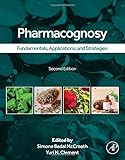Pharmacognosy: Fundamentals, Applications, and Strategies /
Material type: TextPublication details: Amsterdam, Academic Press, 2024Edition: 2nd editionDescription: 846 pages : illustrations (some color) ; 29 cmISBN:
TextPublication details: Amsterdam, Academic Press, 2024Edition: 2nd editionDescription: 846 pages : illustrations (some color) ; 29 cmISBN: - 9780443186578
- RS160 .M33 2024
| Item type | Current library | Call number | Status | Date due | Barcode | |
|---|---|---|---|---|---|---|
 Books
Books
|
Main library Nursing Buliding | RS160 .M33 2024 (Browse shelf(Opens below)) | Available | N5959 | ||
 Books
Books
|
Main library Nursing Buliding | RS160 .M33 2024 (Browse shelf(Opens below)) | Available | N5960 |
Previous edition:
Section 1: Pharmacognosy 101 1. Background to pharmacognosy 2. Traditional medicine 3. Plant anatomy and physiology 4. Plant constituents: carbohydrates, oils, resins, balsams, and plant hormones 5. Plant crude drugs Section 2: Plant metabolites: their chemistry 6. Evolutionary perspectives on the role of plant secondary metabolites 7. Glycosides 8. Alkaloids 9. Tannins 10. Terpenoids 11. Other plant metabolites 12. Vitamins Section 3: Plant metabolites: their effects 13. Chemotherapeutics 14. Bioactive plant molecules, sources, and mechanisms of action in the treatment of cardiovascular diseases 15. Plant metabolites for treating diseases 16. Psychoactive drugs Section 4: Metabolites from other sources 17. Marine metabolites: oceans of opportunity 18. Animal metabolites: from amphibians, reptiles, Aves/birds, and invertebrates 19. Fungal metabolites: a focus on endophytes Section 5: Crude drugs from animals 20. Fats 21. Waxes Section 6: Basic animal anatomy and physiology 22. Basic animal anatomy and physiology 23. Proteins 24. Pharmacokinetics 25. Pharmacodynamics— a pharmacognosy perspective 26. Drug metabolism Section 7: Technological applications using biological systems 27. Biotechnology: principles and applications Section 8 Current trends in pharmacognosy research 28. Nuclear magnetic resonance spectroscopy in drug discovery 29. Metabolomics approach in pharmacognosy 30. Novel targets in drug discovery 31. Nanotechnology: creating, manipulating, and observing nanostructured systems in biology and medicine 32. Ethical aspects of working with local communities and their biological resources 33. Factors to consider in development of nutraceutical and dietary supplements 34. The global regulatory framework for medicinal plants
There are no comments on this title.

